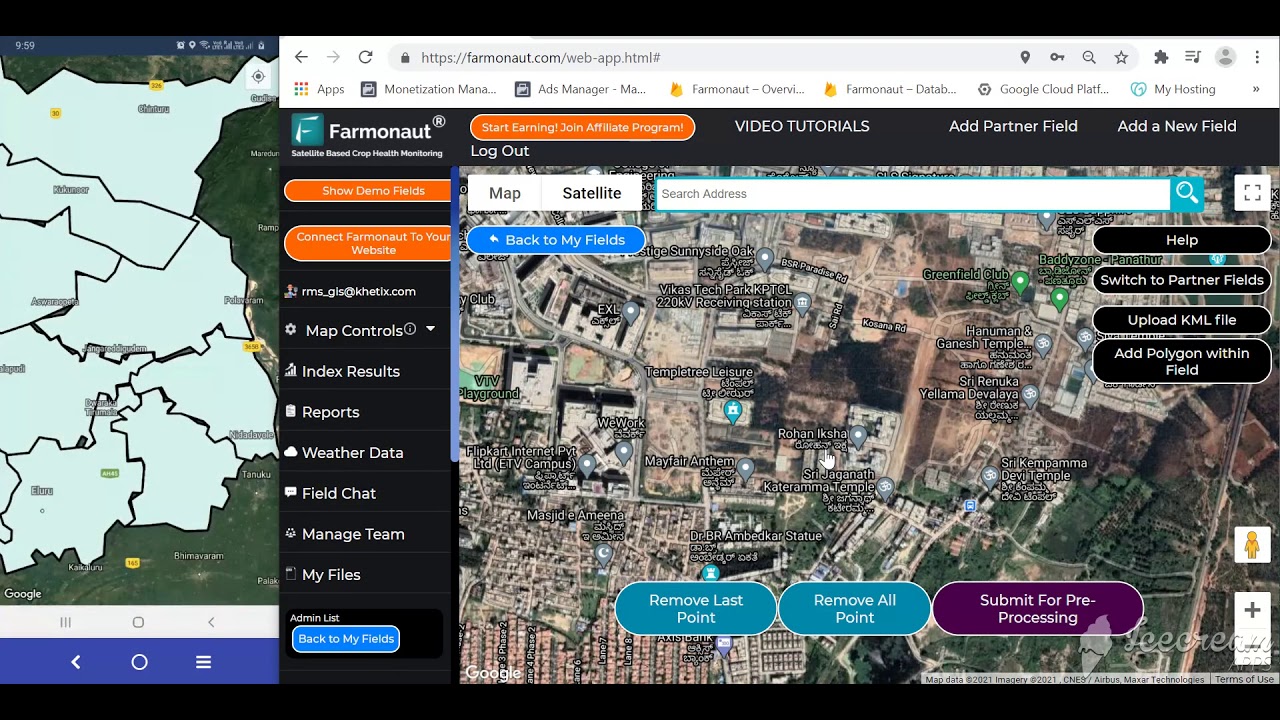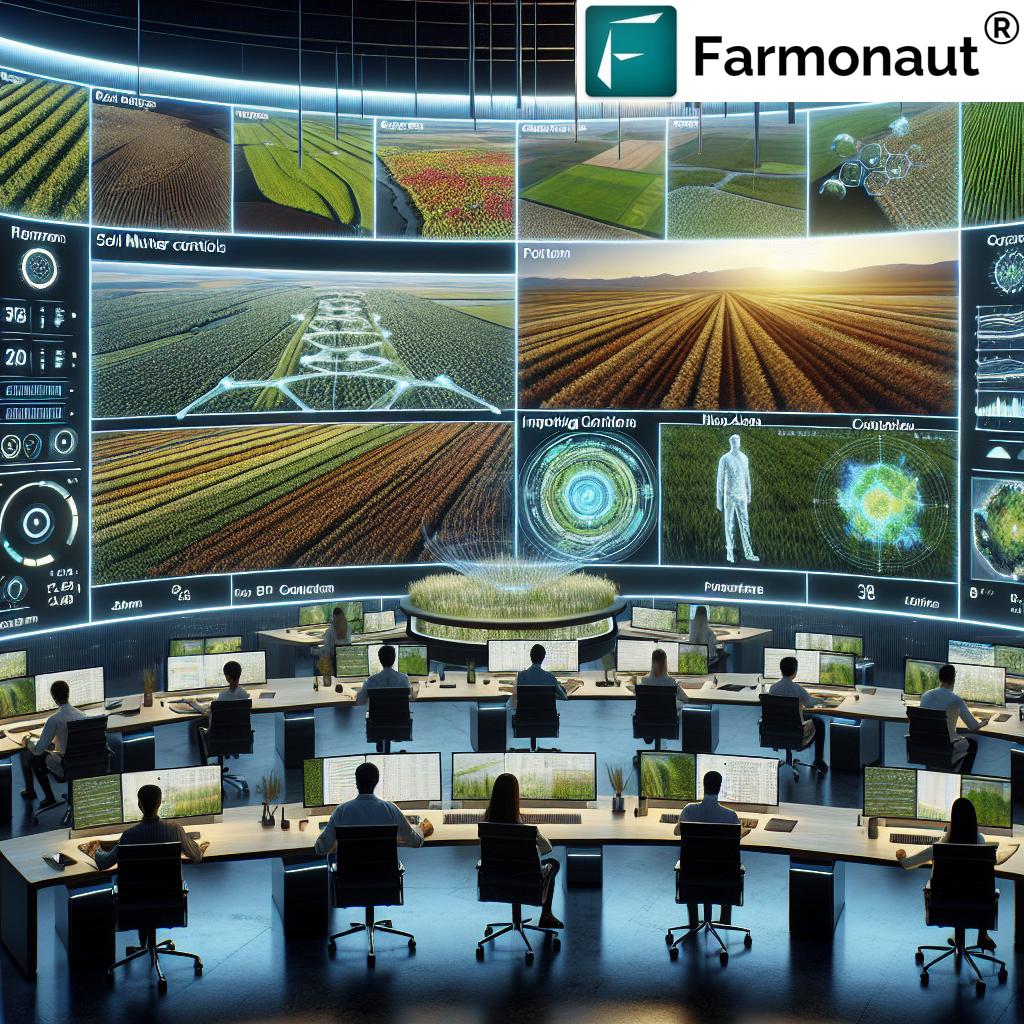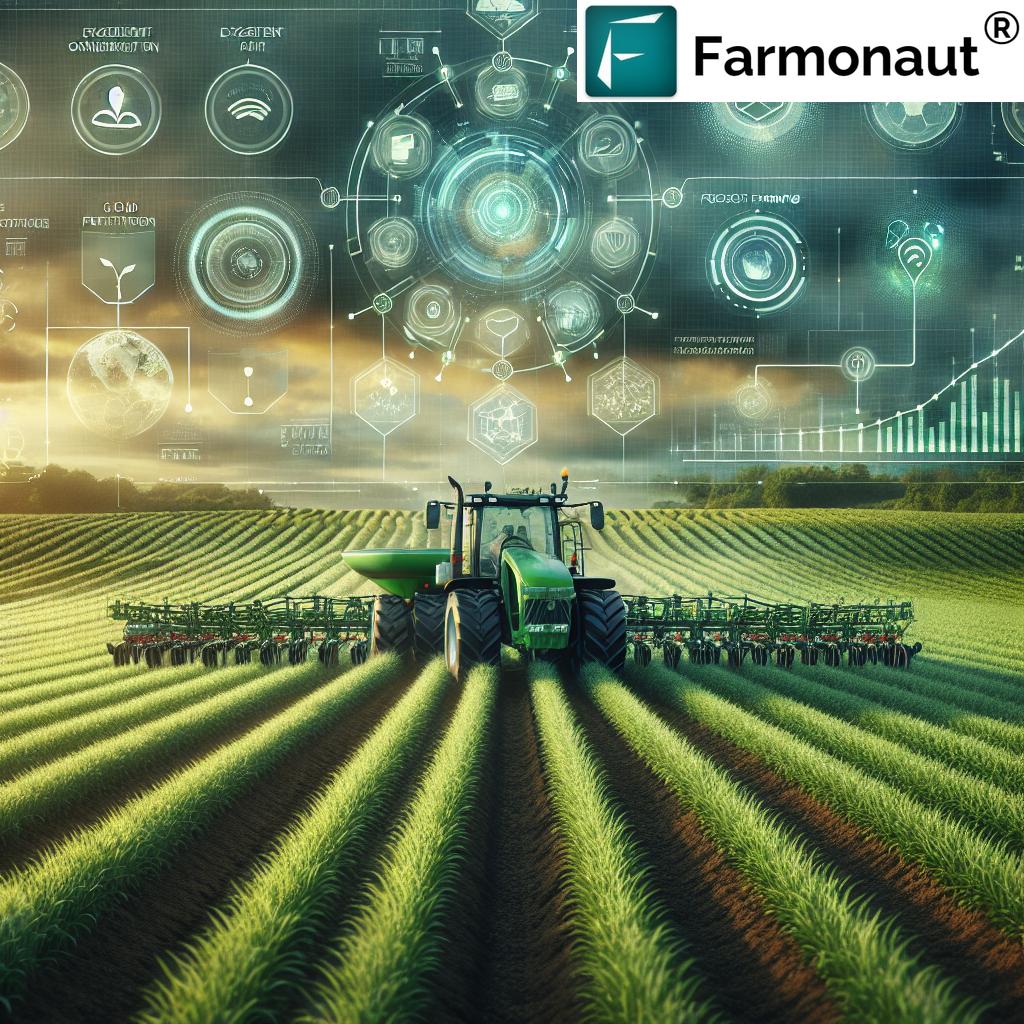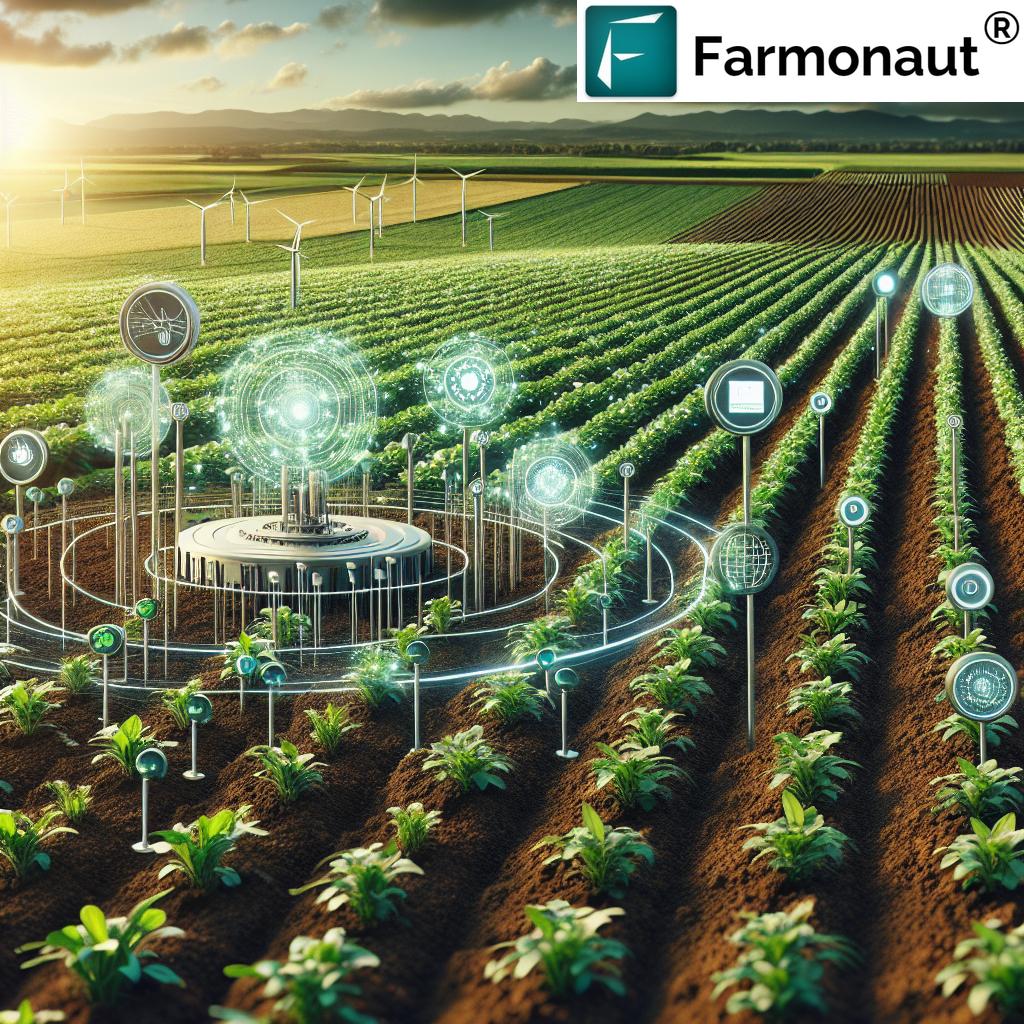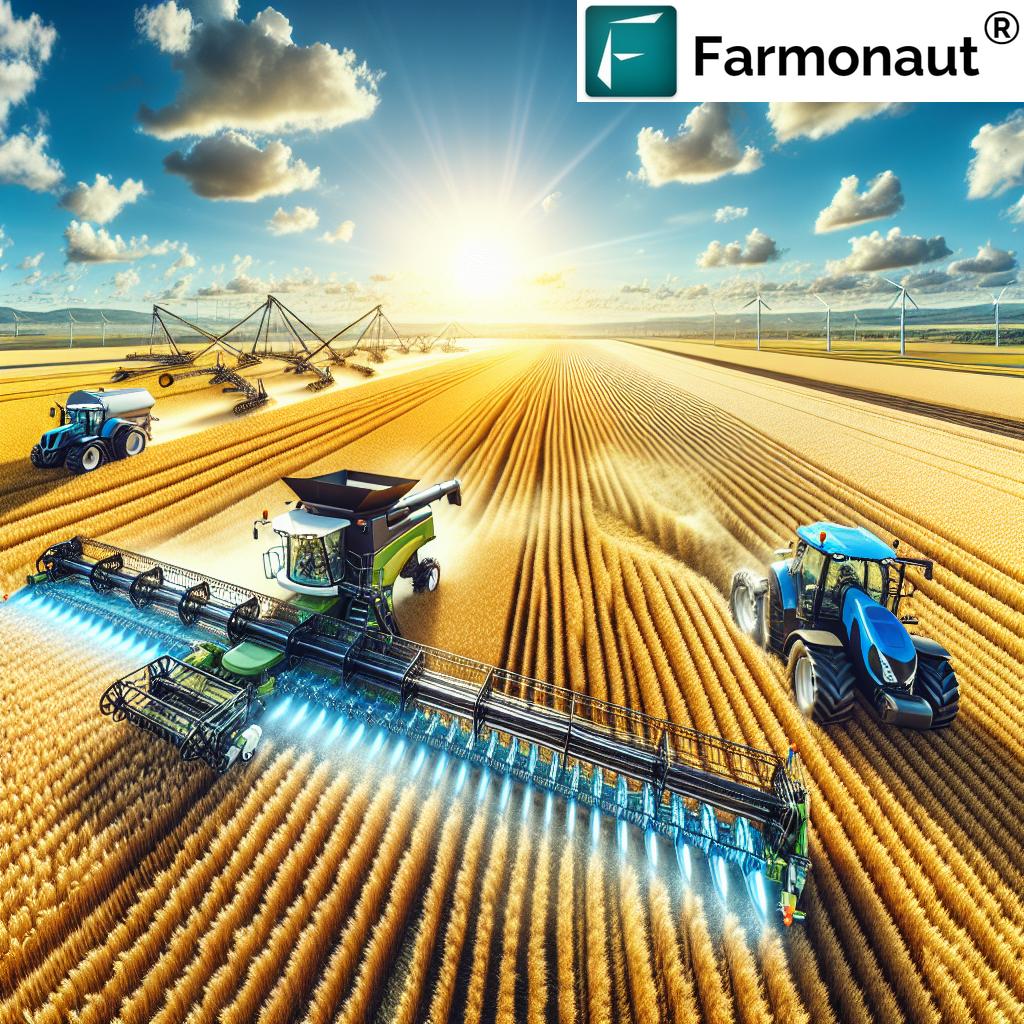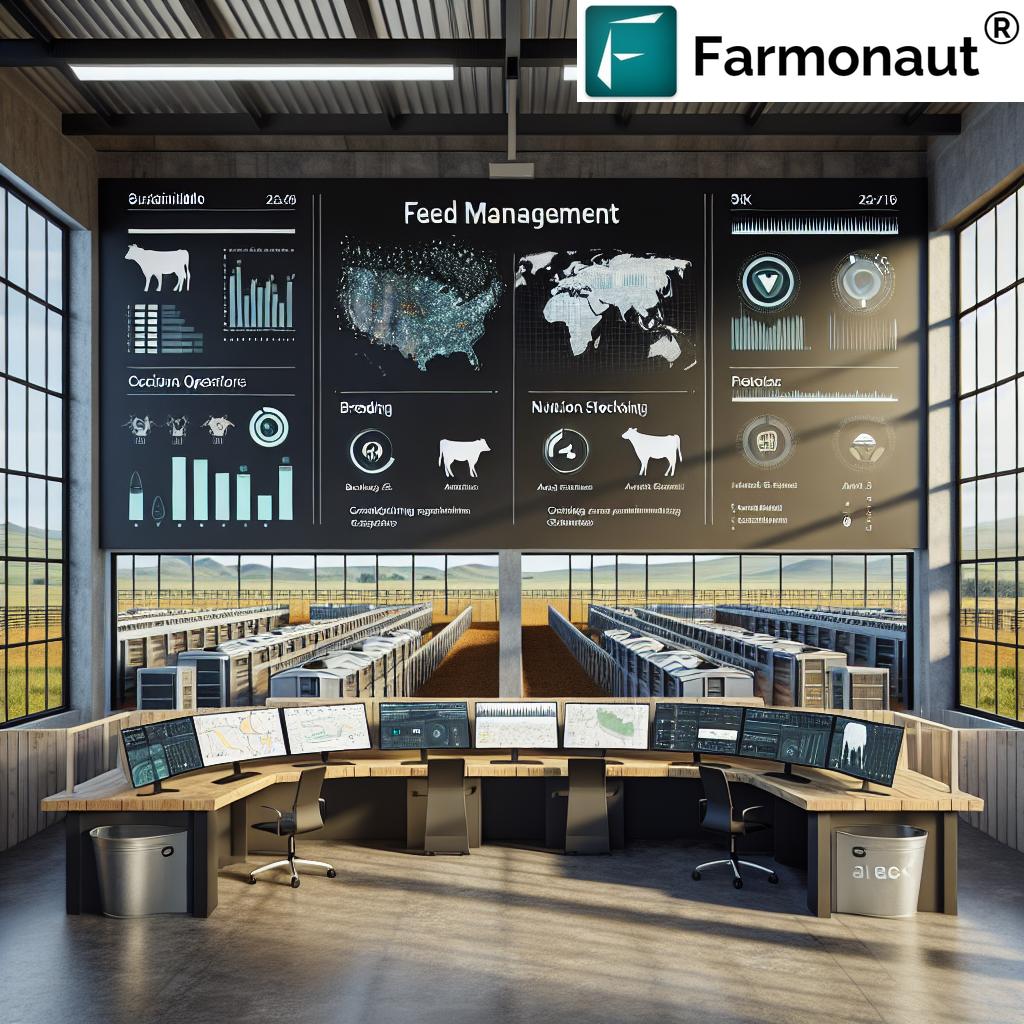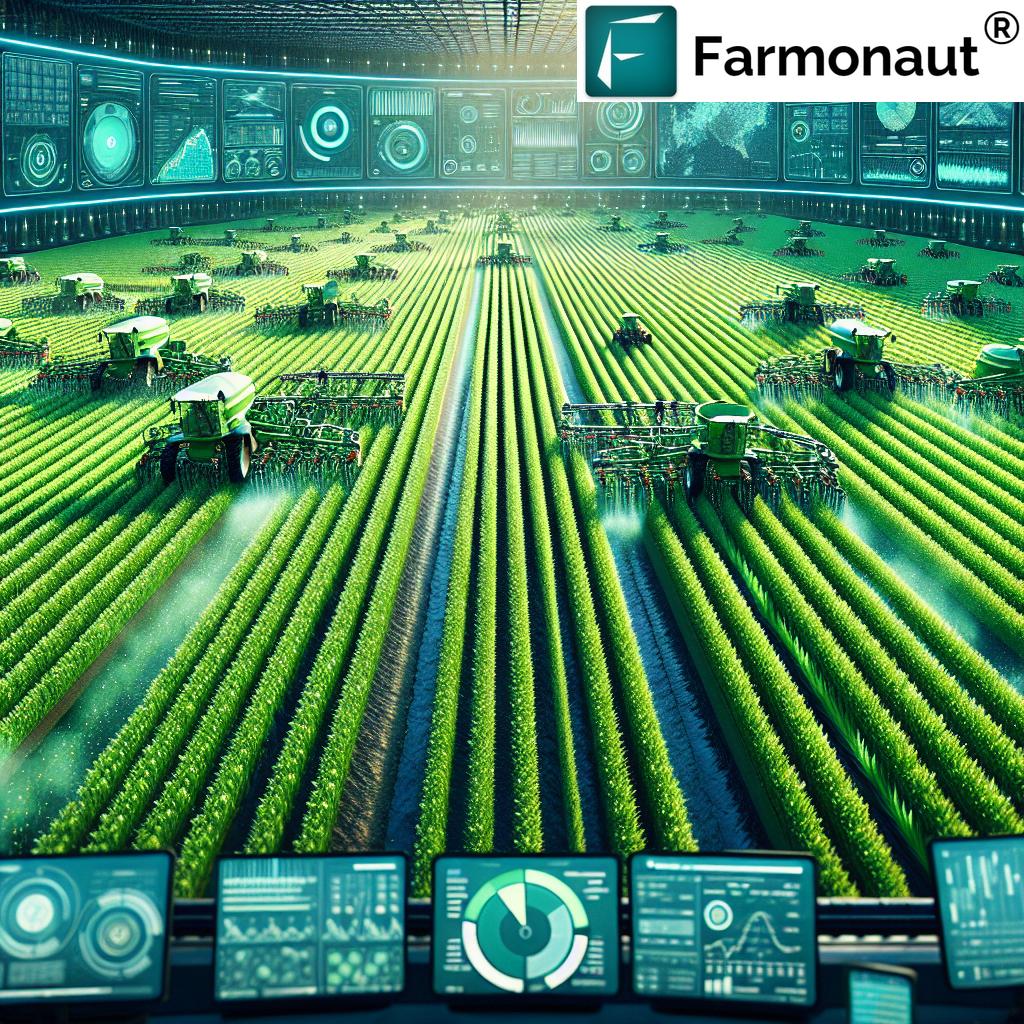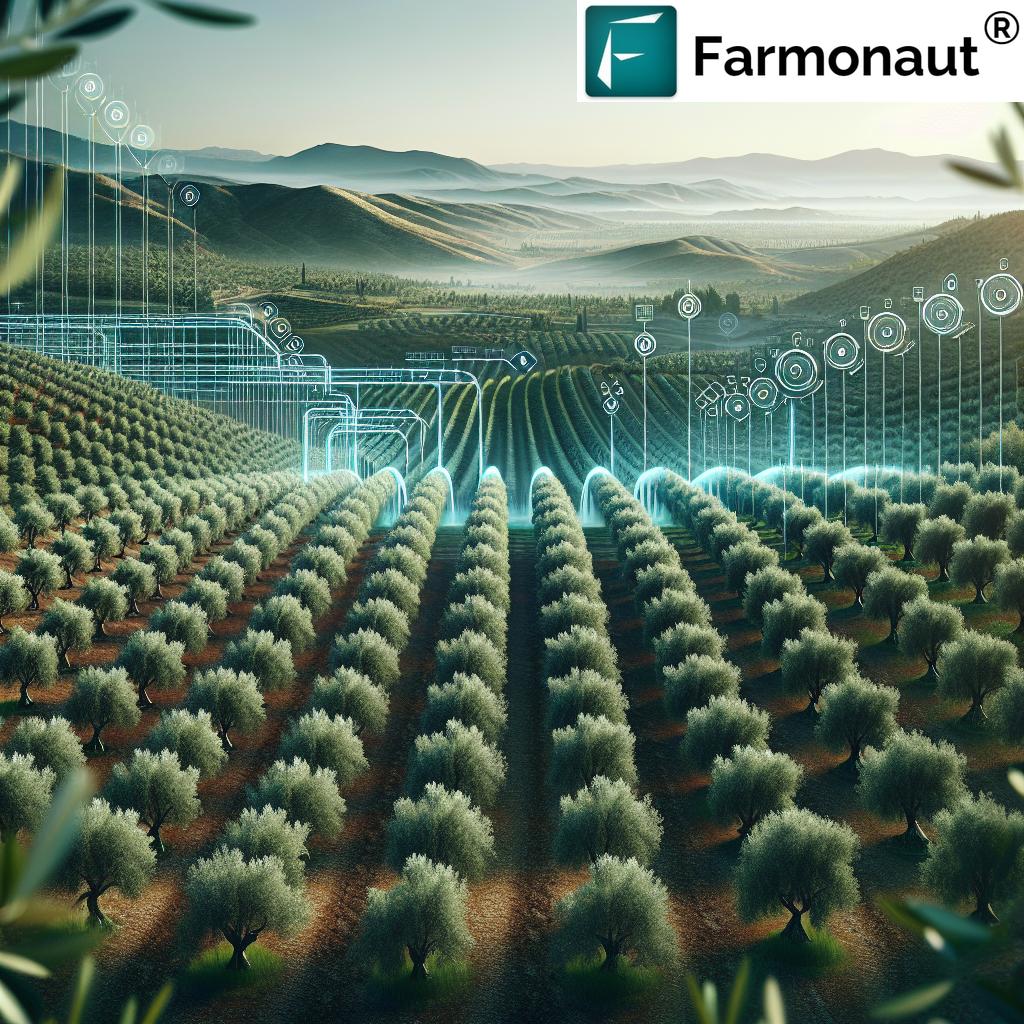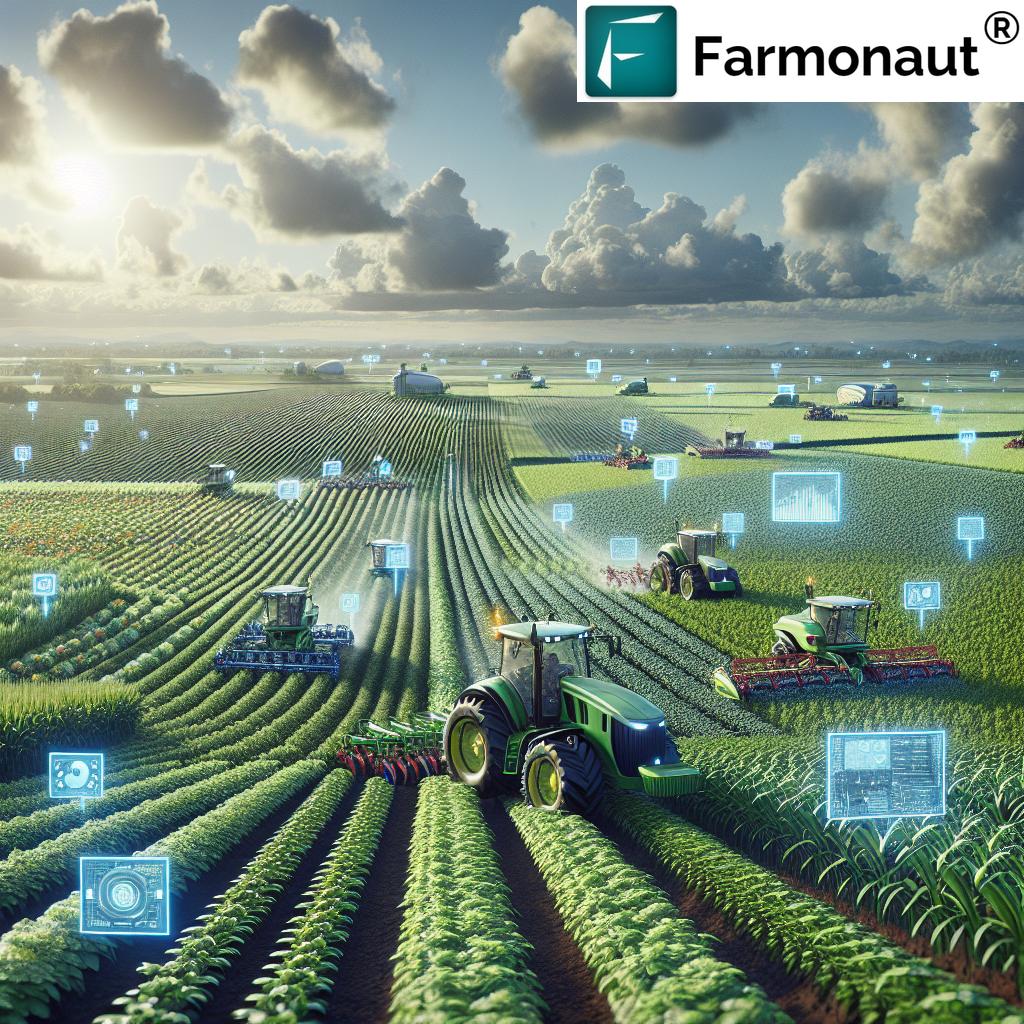Table of Contents
- Introduction: The New Era of Agricultural Tracking
- Precision Farming Trivia
- 1. Precision Agriculture: Data-Driven Farming Excellence
- 2. Remote Sensing & Drones: Crop Monitoring from the Skies
- 3. IoT Sensors in Farming: Real-Time Data Collection & Analysis
- 4. Livestock Tracking Systems: Enhancing Animal Health & Welfare
- 5. Asset and Equipment Tracking: Maximizing Operational Efficiency
- 6. Supply Chain Transparency in Agriculture: Traceability & Trust
- 7. Sustainable Agricultural Practices & Environmental Monitoring
- Farmonaut’s Role in Precision Agriculture
- Precision Farming Technologies: Features & Impact
- Challenges & The Road Ahead
- FAQ: Agricultural Tracking Technologies
- Conclusion: Shaping the Future of Agriculture
Agricultural Tracking: 7 Precision Farming Technologies That Are Revolutionizing Modern Agriculture
“Over 70% of precision farming operations now use satellite imagery for real-time crop monitoring and field analysis.”
The world is experiencing a paradigm shift in how we track, manage, and optimize agricultural and forestry operations. At the forefront is precision agriculture—a set of methodologies and cutting-edge tracking technologies designed to transform data into action for farmers, foresters, and agricultural professionals globally.
From IoT sensors in farming that capture real-time data on soil moisture and crop conditions, to remote sensing in agriculture via satellites and drones, these innovations equip us with actionable insights. The result? Enhanced productivity, superior crop health, resource efficiency, and a more sustainable future for agriculture.
Precision Farming Trivia
“Variable rate technology can reduce fertilizer use by up to 30%, optimizing input application across different field zones.”
In this comprehensive guide, we’ll explore the seven leading agricultural tracking technologies—their principles, key benefits, and how they empower smarter management decisions across farms, forests, and the entire food supply chain.
1. Precision Agriculture: Data-Driven Farming Excellence
Precision agriculture employs advanced tracking technologies, IoT sensors, and GPS-guided equipment to monitor and manage field-level variability in crops, soils, and resources. The core aim is to optimize resource use, enhance crop health, and boost agricultural yields.
Key Techniques & Tools
- GPS-guided tractors and seeders for accurate planting—ensuring seeds are placed at specific depths and intervals for optimal uniform growth conditions.
- Variable rate application systems that adjust fertilizers, pesticides, and irrigation based on data-driven soil and crop monitoring.
- IoT and satellite-based sensors—tracking soil nutrient levels, moisture, and predicting pest infestations.
The result is enhanced productivity, minimized resource wastage, reduce input costs, and greater environmental stewardship.
For those interested in affordable, advanced satellite-based precision agriculture solutions with real-time farm data analytics, Farmonaut’s large scale farm management system enables the monitoring and optimization of vast estates with ease.
Benefits of Precision Agriculture
- Improved resource allocation (water, fertilizers, pesticides)
- Increase in crop yields and quality due to precise nutrient application
- Lower input costs by identifying which areas need attention
- Supports sustainable agricultural practices through targeted resource use and minimizing environmental impact
- Reduced carbon footprint with efficient operations
Farmonaut is committed to making precision agriculture accessible for farmers worldwide. By leveraging carbon footprinting tools and AI-based advisory systems, we empower users to optimize field management and achieve sustainability goals cost-effectively.
2. Remote Sensing & Drones: Crop Monitoring from the Skies
The rising use of remote sensing in agriculture—powered by unmanned aerial vehicles (UAVs), drones, and satellites—has opened new horizons for precise crop monitoring, early detection of plant health issues, and targeted input application.
How Crop Monitoring with Drones & Satellites Works
- Multispectral and thermal sensors on drones capture images at different wavelengths, providing comprehensive insights into vegetation health, moisture levels, and even pest infestations.
- High-resolution aerial imagery helps identify variability and problem areas in fields, such as disease hotspots or nutrient deficiencies.
- Targeted spraying systems use real-time data to apply fertilizers and pesticides only where needed—reducing input costs and minimizing environmental impact.
Farmonaut utilizes multispectral satellite images for advanced crop health monitoring. Our platform’s AI-based analytics decipher NDVI/vegetation health and soil moisture, empowering farmers for early detection and intervention.
- Actionable advice is delivered via the Jeevn AI Advisory System: Data transforms into custom crop management recommendations, weather forecasts, and real-time alerts, directly accessible on Android, iOS, and Web apps.
Key Benefits
- Reduced environmental impact: Precision targeting minimizes runoff, water wastage, and chemical use.
- Proactive management: Early identification of pest or disease issues enables timely interventions.
- Maximized yield: Resource investment matches need, increasing overall field performance.
3. IoT Sensors in Farming: Real-Time Data Collection & Analysis
IoT (Internet of Things) sensors in farming continue to redefine modern agriculture. By interconnecting field devices, weather stations, and crop monitoring tools, these IoT systems transmit critical data—enabling precise decisions and responsive farm management.
Types of IoT Sensors in Agriculture
- Soil moisture monitoring sensors: Measure real-time water content—automatically triggering targeted irrigation and preventing wastage.
- Climate and weather sensors: Track temperature, humidity, light, and wind patterns to forecast optimal planting or harvest windows.
- Nutrient and pH sensors: Detect shifts in soil chemistry enabling timely correction and balancing for crop health.
As IoT sensors continually feed data to analytics platforms (like those in the Farmonaut ecosystem), farmers receive guidance on when, where, and how much to irrigate/fertilize—absolutely transforming decision accuracy and operational efficiency.
Practical Benefits
- Reduced input and water consumption: Irrigation and fertilizer use is dictated by actual field conditions, not guesswork.
- Boosted crop health and yields via continuous monitoring and feedback-driven adjustments.
- Enhanced sustainability: Precision data helps minimize run-off and reduce environmental impact.
For developers and agri-businesses seeking to integrate real-time farm data analytics, Farmonaut’s API and API documentation enable direct access to satellite and field-sensor data—ideal for custom agri-tech solutions.
4. Livestock Tracking Systems: Enhancing Animal Health & Welfare
Beyond crops, advanced tracking systems for livestock (cattle, sheep, goats, poultry, etc.) are transforming how farmers monitor animal health, behavior, and productivity.
Key Tracking Technologies in Livestock Management
- RFID tags: Each animal receives a unique identifier (with a passive or active chip). Movement, health checks, and lifecycle events are quickly recorded and accessible.
- Biometric sensors: Wearables that track heart rate, temperature, and activity for early detection of illnesses or abnormalities.
- GPS collars: Support location tracking for grazing animals, especially valuable for large rangelands and forest-based livestock operations.
Livestock tracking systems deliver critical data for traceability, disease management, and overall welfare. Farmers can swiftly intervene at the first sign of health issues, manage breeding, and optimize feeding programs.
Benefits for Animal Farming
- Reduced mortality and improved productivity via real-time animal monitoring
- Enhanced traceability for food safety and certification (key for export and specialist markets).
- Efficient herd management—less manual labor for tracking and reporting.
RFID tags and biometric sensors are increasingly a standard in advanced livestock operations.
Precision Farming Technologies: Features & Impact
| Technology Name | Main Function | Estimated Efficiency Gain (%) | Crop Health Impact | Sustainability Benefits | Example Use-Case |
|---|---|---|---|---|---|
| Precision Agriculture | Field data-driven management using GPS, IoT sensors, analytics | ~25% | Significant (improved yield & quality) | Reduces input use, boosts soil health | Site-specific fertilizer application to minimize wastage |
| Remote Sensing & Drones | Aerial & satellite imaging for monitoring crop health | ~30% | Early detection of disease & stress | Minimizes chemical overuse | Targeted pesticide spraying based on drone insights |
| IoT Sensors & Data Analytics | Real-time monitoring of field & environmental conditions | 20-35% | Reduces under/overwatering; timely input | Prevents water/fertilizer wastage | Automatic smart irrigation triggered by soil moisture |
| Livestock Tracking Systems | RFID & biometric tags to monitor animal health/behavior | 15-20% | Detects early disease, improves welfare | Reduces medicine overuse, losses | Automated health alerts for dairy cows with RFID collars |
| Asset/Equipment Tracking | Telematics for machinery & vehicle monitoring | ~15% | Minimizes downtime, improves inputs logistics | Optimizes fuel, enhances equipment life | GPS-tracked tractors with maintenance alerts |
| Supply Chain Transparency | Blockchain for product traceability farm-to-consumer | 10-18% | Reduces fraud, maintains quality | Less waste, ensures sustainable sourcing | Blockchain-traced coffee supply chain |
| Sustainable Monitoring Systems | Smart resource management; carbon footprinting | 10-25% | Enhanced via resource efficiency | Reduces emissions, resource depletion | Dynamic irrigation adjustment to reduce water loss |
5. Asset and Equipment Tracking: Maximizing Operational Efficiency
Modern precision farming extends beyond the field to encompass every piece of equipment involved in agricultural operations. Telematics systems and advanced tracking tools ensure that tractors, combines, irrigation systems, and implements are used efficiently, cost-effectively, and sustainably.
Core Features of Equipment & Asset Tracking
- GPS-based equipment location: Real-time dashboards for knowing where every machine is operating.
- Monitoring performance parameters: Fuel consumption, operating hours, and task completion.
- Predictive maintenance & scheduling: Receive alerts when service is due or potential issues are detected (minimizing costly breakdowns).
By integrating fleet and resource management tools—like the ones available in the Farmonaut Fleet Management Module—agri-businesses and cooperatives can not only track equipment usage in real-time but also optimize logistics, reduce idle time, and lower maintenance costs.
How Asset Tracking Boosts Efficiency
- Identifies equipment bottlenecks and over- or under-utilization
- Facilitates timely maintenance and reduces unplanned downtime
- Improves overall machine life and reduces environmental impact (e.g., via fuel optimization)
6. Supply Chain Transparency in Agriculture: Traceability & Trust
Consumers and food companies demand to know the origin and safety of agricultural products. Digital tracking technologies like blockchain make the entire journey—from seed to table—completely transparent, authentic, and fraud-resistant.
How Supply Chain Tracking Works
- Blockchain-verified records track every product batch from harvest through processing, shipping, and retail.
- IoT sensors track storage conditions (e.g., temperature, humidity, handling) throughout transit.
- QR-codes or RFID tags on packaging allow instant product verification by retailers and consumers.
Farmonaut’s blockchain product traceability module delivers unrivaled supply chain transparency for agriculture, pharma, textiles, and more—protecting brands, consumers, and producers through verified data at every stage.
Benefits for the Agriculture Sector
- Strengthen trust and brand loyalty among buyers and partners
- Enable premium pricing for verifiable “farm-to-fork” products
- Prevent fraud or counterfeiting in critical markets such as organic, specialty, and export crops
- Enhance food safety, recall management, and regulatory compliance
Secure, streamlined, and customer-friendly traceability solutions are now a vital part of sustainable agricultural practices.
7. Sustainable Agricultural Practices & Environmental Monitoring
At its core, agricultural tracking is also about aligning productivity with sustainability. Modern tracking systems enable precise application of water, fertilizers, and pesticides—significantly reducing the risk of resource depletion and environmental degradation.
Features of Environmental Monitoring in Agriculture
- Soil health monitoring: Real-time data on erosion, organic matter, and microbiome status.
- Smart irrigation systems: Soil moisture monitoring directs water application only where and when needed—saving water and improving yields.
- Input optimization: Variable rate application systems minimize overuse of fertilizers and pesticides.
- Carbon footprint tracking: Real-time insights on emissions produced by farm operations; essential for climate-smart farming.
Farmonaut’s carbon footprinting platform (learn more here) equips agribusinesses to track and reduce greenhouse gas emissions. These features enable more socially responsible and compliant agricultural practices.
Key Impacts
- Protects local water resources through precise irrigation
- Prevents soil degradation and preserves fertility for the long-term
- Boosts profitability by reducing waste and maximizing output
- Supports sustainable certification and market access
Farmonaut’s Role in Precision Agriculture, Crop Tracking & Decision Support
At Farmonaut, our mission is to put precision agriculture within reach for every farmer, agri-business, and institution—worldwide.
What Sets the Farmonaut Platform Apart?
- Satellite-Based Crop Health Monitoring: We leverage multispectral satellite imagery to provide timely updates on crop health (NDVI, moisture, and vegetation indices) for effective farm management and early detection of issues.
- AI-Based Crop Advisory (Jeevn AI): Personalized, actionable farm recommendations based on satellite and sensor data to improve yield, efficiency, and sustainability.
- Carbon Footprint Tracking: Helps producers and agribusinesses monitor and minimize their environmental impact.
- Blockchain Product Traceability: Enhances trust and supply chain transparency in agriculture for crops, textiles, and beyond (learn more).
- Fleet and Asset Management: Enables tracking and optimizing the use of agricultural machinery and vehicles (details here).
With our mobile, web, and API interfaces, users can track their farms, forests, and plantations from anywhere—accessing powerful analytics, historic comparisons, and custom alerts that truly drive better agricultural decisions.
Our Value Proposition Includes:
- Democratizing access to satellite technology for all scales of agriculture
- Reducing costs versus on-ground hardware-intensive solutions
- Supporting scalable deployment—from smallholder farms to large plantations and government programs
- Providing real-time, actionable intelligence on crop health, water usage, and carbon footprint
- Bolstering sustainability, compliance, and market certification efforts
Discover how our large scale farm management solutions make precision agriculture affordable, accessible, and effective.
Challenges & The Road Ahead
Despite these advancements, adoption of advanced agricultural tracking technologies is not without challenges:
- High initial investment: The upfront cost for drones, IoT sensors, and telematics systems can deter small-scale operators.
- Lack of technical expertise: Effective use of these systems requires training, support, and digital literacy.
- Data privacy and integration: Managing, securing, and integrating large data from diverse sources is complex but essential for interoperability and trust.
- Connectivity: Rural or remote areas may have limited internet access.
However, as the cost of technology falls, API-based integrations improve, and user-friendly platforms (such as Farmonaut’s) become more widespread, the future of agricultural tracking is set for even greater expansion.
What’s Next in Agricultural Tracking?
- Greater focus on affordability and accessibility so every grower can benefit
- Advances in machine learning & predictive analytics for more precise forecasts
- Easier integration of satellite, sensor, and equipment data in holistic dashboards
- Stronger roles for AI, blockchain, and carbon tracking in compliance and market differentiation
FAQ: Agricultural Tracking Technologies
What is precision agriculture and how is it different from traditional farming?
Precision agriculture uses data-driven techniques (like GPS, IoT, satellite imaging, real-time analytics) to optimize resource usage and crop management at a granular level. In contrast, traditional farming relies on uniform treatment with less adaptation to field variability, leading to higher input costs and inefficiencies.
How do IoT sensors in farming benefit operational efficiency?
They provide real-time information on soil moisture, weather, and crop growth. This enables precise irrigation, optimal fertilizer application, and early detection of plant stress or pest issues—boosting yields and reducing costs.
Are drones truly beneficial for smallholder farmers?
Yes. Entry-level drones and especially satellite-powered monitoring (farmonaut.com) lower cost barriers, giving smallholders access to timely field analysis, health detection, and interventions—without large investments in hardware.
Why is supply chain transparency in agriculture important?
It assures consumers that products are authentic, safely handled, and ethically sourced. Blockchain-based traceability protects from fraud, enables premium pricing, and is increasingly required in exports and specialty markets.
How can I get started with precision farming solutions affordably?
Exploring software platforms like Farmonaut’s real-time farm management app is a cost-effective way to harness precision tech, analytics, and crop monitoring without purchasing expensive on-ground hardware.
Where can I find documentation for Farmonaut’s API?
The Farmonaut API Developer Docs are available at this link—enabling integration of satellite analytics and real-time field data into any agri-business solution.
Conclusion: Shaping the Future of Agriculture with Tracking Technologies
Agricultural tracking technologies are propelling the sector into a new era—one where every drop of water, every application of fertilizer, and every field operation is guided by real-time intelligence. Data-driven decision-making, resource efficiency, and sustainability are no longer aspirations but daily realities for modern farmers and foresters.
Whether it’s satellite-powered crop monitoring with drones, IoT sensors in farming, livestock tracking systems, or farm-to-fork traceability, these tools are transforming lives and landscapes—making agriculture more productive, sustainable, and resilient.
Solutions like Farmonaut’s platform make top-tier precision agriculture available to everyone—helping us all grow more, waste less, and protect our world for future generations. Ready to explore the future? Start your transformation with Farmonaut’s precision agriculture app.








